Are comic books really not for kids anymore if their pretenses at intellectualism are taking shape as the miasma of rhetoric excusing the straightforward use of crude racist stereotypes by white male cartoonists as satirical and over the heads of the rest of (x) unsophisticated rubes. And hey, is the racist iconography in question even really a known quantity, or something the cartoonist deliberately inserted to provoke reader (x)’s assumption that it is exactly what it looks like, dummy (x).
I’ve used sarcasm to draw your inference that I meant the opposite of the words I just typed (I am very sophisticated). Ugly, stereotyped, demeaning images of non-white people are racist. As Dr. Henry Louis Gates Jr has pointed out specifically, sambo art’s past prevalence (or onmi-presence) in society was a deliberate social tool to shape dominant white attitudes about black people with the specific goal of dehumanizing and politically repressing them, which is exactly what happened (continues to happen). The lines on paper, the blots of ink, when arranged in this way traces a current of malice from history to the artist’s hand today. Even though it’s fashionable in some circles to affect a veneer of cash-and-carry general repulsiveness as a shield against any specific allegation of consciously doing ill with ink on paper, degrading racist cartoons do hurt people.
This is supposed to be funny under the assumption that this is scenario is alien to white Westerners. It is not because it is not.
How we cartoon people is important, even if we’re cartooning people as animals. I’ve written previously (before I was officially HU’s correspondent on Furries) about the furry detective comic Blacksad and transposing human racial attributes onto a setting with anthropomorphic animals. Blacksad is not an example of a lucid and well-measured application of this trope. In fact, it’s a disaster. In contrast to Blacksad’s racialized concept of speciation, I remember reading the cartoonist Dana Simpson mentioning in a response to a reader question that using funny animals was a way to avoid racial prejudice in a reader as a barrier to empathizing with each character. Cute animals are just cute animals. The pitfall here is that without context, characters in this setting can sometimes be read as white by default. Still, some funny animal cartoonists elect to take the route of no thought or consideration and draw the same offensive stereotypes, but now it’s a cat. This is an old idea. Look at Mickey, here.
The Mouse’s features mirror those of his companion, though it’s clear that Mickey is supposed to read as white, in blackface, and his purpose in this cartoon is to humiliate his black counterparts. Of course these cartoons have been buried as an embarrassing fart of less-enlightened history. I can’t help compare the racist Mickey Mouse pictures to their contemporaries from the old Fleischer Studios, where black music and performance were showcased; rotoscoping technology turning the magnificent Cab Calloway into a spooky ghost in Snow White. Bimbo the dog shares Mickey’s white/black distribution of shade, but less of the minstrel attribution.
When I was studying comics at the SCAD campus in Lacoste, France, and later goofing around in Spain, I discovered that cartoonists were still drawing funny animals this way. In Madrid, a sambo holding a saxophone at a jaunty angle spray-painted on the wall with the text “jazz club,” etc etc etc. I was shocked and puzzled at the ubiquitous caricature of non-white people I saw in the comics shops in the Latin Quarter and Montmartre and Angouleme that only the boldest and self-consciously controversial American artists would think of rendering. In my extreme naivete, I just didn’t… mention…. how weird it was, at the time. In Apt, I even picked up second-hand copies of two of Jean Leguay (aka Jano’s) travelogues, Carnet D’Afrique and his collaboration with fellow cartoonists Dodo and Ben Radis, Bonjour les Indes. Inside, Jano’s uproarious, chaotic, sensational, grotesque drawings show an exaggerated portrait of the places the French cartoonists is fond of visiting.
From Bonjour les Indes.
While often poking fun at clueless white tourists, the book generally portrays Indian people as dirty, simple, venal, self-interested and exotically dangerous, mostly for comedic effect.
His characters are ducks, dog-things, sometimes vaguely bovine creatures with generally blank features, skin like pitch and painted red lips, their individual qualities, background, social status differentiated primarily by costume. It’s a jarring tableau, the post-imperial plundering of faux-quotidian details for broad, sometimes brutal comedy intertwined with mundane, naturalistic, documented daily life that we Americans omit from our envisioning of the world when we reflexively chide ourselves for our “first world problems.” Jano’s travelogues sometimes humanize overlooked experiences while simultaneously reveling in images, exoticism and racist stereotypes meant to dehumanize them. We see people in markets, at the cinema, on a train, buying a guitar, and on the last plate of Carnet D’Afrique, a comic beheading with a sword. Jano has an eye for detail, but too often he misuses it. Instead of highlighting the richness and variety of the lives of his subjects, he instead focuses on sordidness, a cheap thrill here, an ugly little chuckle there, which diminishes them. Gallows humor is a wonderful thing, but artists should keep in mind who erects the gallows and who swings from them.
Reading these books, I can’t really find a reason why Jano draws the people in his travelogues as anthropomorphic animals instead of humans. What thought went into the creation of these images other than “this will look cool?” My great fear, especially writing my own funny animal comic, is that there really is no right way to translate human culture into a world of differentiated animal species that isn’t glib, clumsy and married to racist narratives. Are animal people inherently cruder and cheaper and less dignified than people-people? Was that the whole purpose of the funny animals’ creation? Does drawing a racist image as a dog deflect from the awfulness of the image, or does it enhance what is already a purposeful dehumanization? If furry art is, as I think it is, or ought to be, an imaginative space, furry artists have to consider the historical backdrop in which funny animals have been used and misused to represent people, and do better. Much, much better than’s been done before.
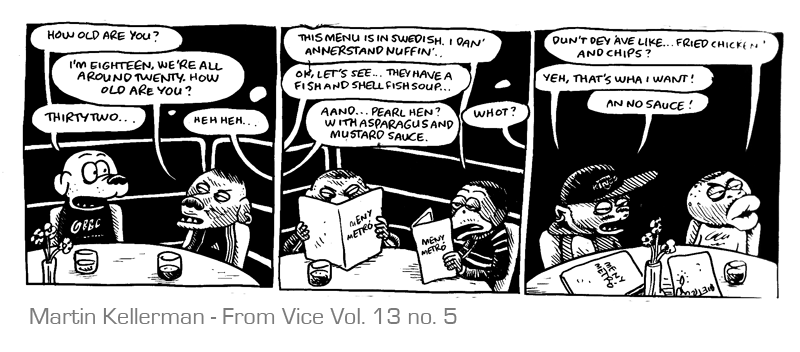
For god’s sake at least better than this. Yiiiiiiiiiiiiiiiiiiiiiiiiiiiiikes.

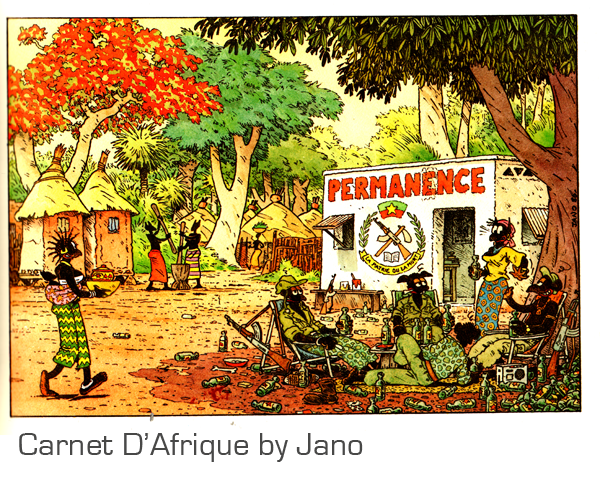
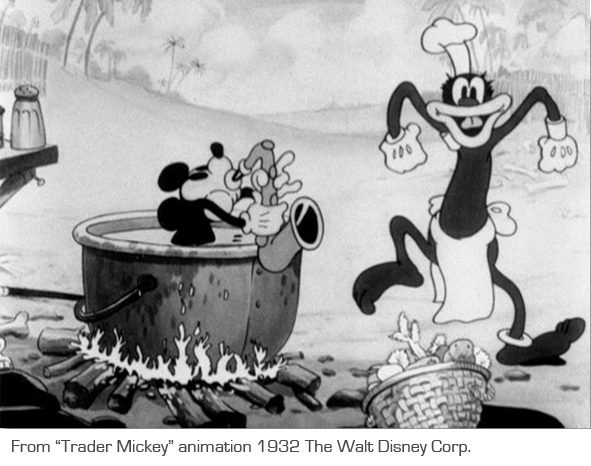
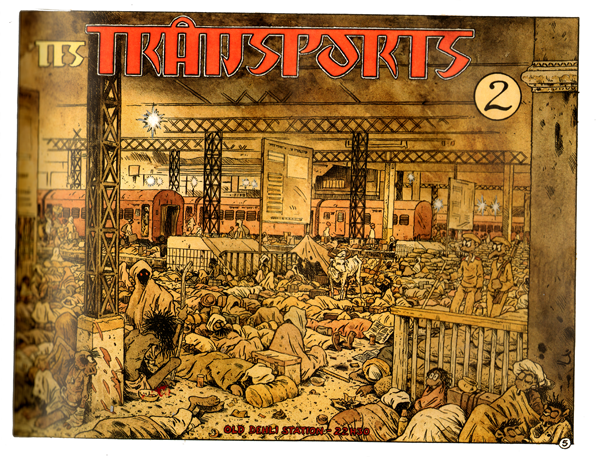
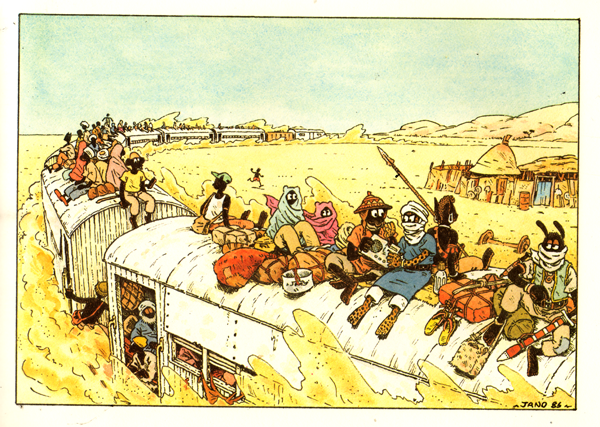
“Reading these books, I can’t really find a reason why Jano draws the people in his travelogues as anthropomorphic animals instead of humans.”
Jano has ALWAYS drawn crude anthropomorphic characters, see for exemple is quite-known ‘Kebra’ about the French punk scene of the eighties. But I guess easy indignation is more convenient than fact-checking…
PS: “Carnet d’racisme entre les animaux” doesn’t mean anything in French.
The fact that he’s done it before doesn’t mean he’s got a reason for doing it. If anything, it just suggests that he’s thoughtless and didn’t consider the implications of what he was doing.
…
Why would he need a reason? Drawing anthropomorphic characters is one of the aspect of his style, like Trondheim. He’s always done it. Maybe he doesn’t know how to draw non-anthropomorphic character properly. Why would he make an exception for a travelogue? It’s as stupid an accusation as to say that Jano assume white people are nothing more than young junkies listening to loud music while being drunk on on drugs (the only kind of characters in the ‘Kebra’ series).
The author of the article should have developped the “book generally portrays Indian people as dirty, simple, venal, self-interested and exotically dangerous, mostly for comedic effect” part: here lies the potential racism, not in the anthropormophism.
Sorry for the typos and grammar mistakes :$
GR: You’re missing the point. The article presents Jano’s work as just one example of a common phenomenon, racialized animal characters. It’s almost never done well. Tying animal traits to racial stereotypes makes the analogy more dehumanizing, not less. That’s an adequate reason to be careful with them.
Maus is the single example I can think of where the author successfully uses species to represent race. But the choice to use animals at all was a direct reaction to anti-Semitic Nazi propaganda. The rodent faces themselves are blank masks, avoiding caricature altogether.
Right; the point is that it’s a tradition that has problems dealing with issues of race for historical and formal reasons. Failing to address those problems, for whatever reason, can leave you perpetuating stereotypes and participating in racist caricature, whether you intend to or not.
Jolly: In Jano’s work, animals are not racialized. He doesn’t use a particular animal to represent a particular ethnic group. He just uses animals, as he does all the time. It would be more problematic if he used different animal for different ethnies.
I agree with you that “tying animal traits to racial stereotypes makes the analogy more dehumanizing” but here, it’s totally irrelevant as Jano doesn’t tie anything (even if one could criticize the use of big red lips for black people). The author of the article touched a real (and well-known) problem, but illustrates it wrongly.
I even think that if Jano had diverged from is usual style just because he was representing non-Westerners, it would have been for the least condescending…
In between, some people question Spiegelman choice, and think it’s racist. Cf. the (pseudo-)scandal regarding Ilan Manouach’s Katz, at Angoulême 2012.
NB: “Failing to address those problems, for whatever reason, can leave you perpetuating stereotypes and participating in racist caricature, whether you intend to or not.” I strongly disagree with you. Why is it racist, when an author draw an Indian character exactly as he would draw a “traditional” Frenchman, except for the color of the skin?
I’m not familiar with Jano’s work. But those images up there appear to be accessing a history of racist iconography. It’s quite possible that that was not his intent. However, given the history of analogizing black people to animals, and the history of racist iconography, his cartoons can easily end up saying something he didn’t quite mean. Not having rudimentary control of some of the most obvious connotations of your work is an artistic failing. In my opinion.
Well, try to find image of his previous works, it’s often overloaded and “dirty” (a typical exemple: http://www.du9.org/wp-content/uploads/img/jpg/Jano.jpg). Apart from the colour, he draws Indians as he would draw Whites, and he draws Blacks as he would draw Whites (except indeed for the slightly racist bigger lips, and not on all characters).
Moreover, the fact he uses different animals for non-Westerner shows he doesn’t want to use the usual easy stereotype “one animal=one ethnic group” and that Blacks/Indians people aren’t an undistinct whole but are as diverse as White people. It’s totally different from Hergé who intentionally drew Black people all the same and White people all different…
The harm is only in your eyes, because you don’t know Jano’s work nor the anthropomorphic tradition of French comic books (Rochette or Ptiluc in the eighties also used that a lot in adult comics), and maybe because you want to see racism as soon as a non-Westerner is represented. An artist can’t control that intention…
But anyway, I don’t really like Jano. I think his stories are confuse and often boring. So maybe someone could explain to me why Kellerman’s strip is supposedly less racist than Jano’s one? I don’t know his other works and I only see here caricatural Black guys talking about fried chicken in a mock AAVE…
I think the real problem here is that anthropomorphic cartooning has very limited utility (e.g. in humor; political, satirical or otherwise) and is frequently a failure when dealing “seriously” with “serious” issues.
I can’t tell whether Jano’s work is racist from the above examples. What are the rest of his travel scenes like for example? Are those images mitigated by the rest of his drawings concerning India and Africa? I’ve seen similar (less congested) scenes at train stations in my travels through India so it’s not completely inaccurate. But the anthropomorphics add very little to the subject matter (just imagine what a photo of the same scene would look like). It’s poverty porn by any measure.
As for the anthropomorphics in Maus, I see that as a useful tactic considering Spiegelman’s inability to consistently draw interesting people (yes I’ve seen Prisoner on the Hell Planet). It’s also worked quite well as a marketing gimmick though I doubt if this was the original intent. Book synopses describing Nazis as cats, Jews as mice, and Poles as pigs work quite well to soften and sell the Holocaust. It also gives critics something to write and argue about.
GR: Michael isn’t saying Kellerman’s strip is less racist. Also, less racist than Herge is not exactly an endorsement.
Suat: I agree re: the marketing gimmick.Not sure it’s unintentional though. Or at least, he kept using it in Shadow of No Towers for reasons that appeared to be brand related.
If Jano is a cartoonist whose default style or mode is anthropomorphism, when he chooses to draw cultures that are not his own, he’s kind of doomed either way. It goes back to anthropomorphism implying a white norm, where racialized characters have to be indicated with stereotyped features (not unlike with female funny animal characters.) I wonder if it would be even stronger poverty porn had he rendered Indian people naturalistically, but continued to draw white punks as animals. But perhaps not. Maybe the key is in showing individuals, as opposed to having an Ur caricature represent a race, as GR mentioned. This piece raises a lot of good issues on this.
NB: I may have misread the “For god’s sake at least better than this.” but it seems to me that the author states Kellerman is less racist than Jano.
And anyhow, you didn’t answer what I said in my second paragraph about the representation of people as individuals that annihilates the potential implied racism (according to you) in representing non-Whites as anthropomorphic characters.
He’s saying that Kellerman is the low point; folks should be able to do better than that.
Representing people as individuals is good. If you’re accessing animalistic and blackface stereotypes without thinking about them or addressing them, I would say you still have a problem, though.
As Kailyn says, and as the article suggests, it may be a problem with the form itself; that is, there just isn’t a good way to represent other cultures via funny animals.
Suat, Noah — regarding Maus, I was wondering what kind of style Spiegelman should have employed in you mind (if it wasn’t for his “inability”). Or what artist would have been more suited to draw a Holocaust comic? You probably heard this argument before, but the distance this ironic style creates really helps Maus a lot to avoid being lachrymose in my eyes. Or maybe you think Holocaust comics are a bad idea in general?
Speaking as one who’s followed Jano from his very first comics, I have to say that G.R. is 100% right here. Jano’s Black or Indian anthropomorphised characters are indistinguishable, zoologically or morphologically, from his White characters.
The post had its heart in the right place, but it was waaaaaay off base.
I’m just not a big fan of Maus in general, though it could be worse. I talk about these issues a bit more here, if you’re interested. There are several interesting disagreements in comments too.
Thanks for the link Noah. I didn’t want to get into a general Maus debate or anything, I just was surprised both of you would condemn Spiegelman’s art as a marketing gimmick, while I thought the anthropomorphic style was exactly the trick that made the story work (in the way that the distance it creates, it’s actually more touching than any naturalistic artwork would allow). And I just wondered what you thought would have been an alternative.
I don’t think “marketing gimmick” and “trick that made the story work” necessarily contradict each other.
Suat’s saying that it was the best alternative given Spiegelman’s artistic limitations, which seems like it may well be the case.
haha come on Noah. Yeah, making a story work doesn’t hurt selling a book, but I wouldn’t say quality is a “marketing gimmick”.
Regarding Spiegelman and Maus, while his artistic limitations certainly must have been part of his decision to use cats and mice, there are other reasons that this choice was entirely suitable to the story he initially set out to tell: specifically the use of vermin imagery in Nazi propaganda combined with a riff on funny animals as used by Disney and others (remember that the initial strip appeared in an anthology called Funny Aminals (http://comixjoint.com/6_site_graphics/*Covers/2_Underground/funnyaminalsb.jpg). But this approach got a bit bogged down by his subsequent attempts at following up on it as a necessity of the story he was telling. He had to have Polish characters and made the decision to depict them as pigs; unfortunately, this choice ended up becoming the main focus of a lot of criticism at the expense of talking about the actual story. He could have handled it differently I suppose.
I wonder if Fieval’s family in An American Tail are supposed to be Jewish.
I also wonder why the school fundraiser collectible keychains at the 90% African-American middle school I teach at are monkeys: http://www.maranausd.org/DocumentCenter/Home/View/39358
I mean, they’re really cute and come in a lot of different and non-degrading poses and costumes, but like… why monkeys??? Why not dogs, or something with less of a fraught history?
Tim, you don’t listen to enough pop.
Fievel’s family are definitely, absolutely intended to be Jewish. They’re escaping a pogrom, if I remember correctly? And the accents? I might be misremembering it. Interestingly, American Tale and Maus came out around the same time didn’t they? And while American Tale uses anthropomorphism to address larger social and historical issues with children, Spiegelman uses anthropomorphism to address parallel issues with adults (additionally, adults who would have found a naturalistic telling too sentimental.) It’s like the fable of the faun and the man, where the man disgusts the faun by using his breath to both warm and chill things… Following the idea, anthropomorphism seems to be like our ideological body temperature, inherently conservative– it only appears to make things hot or cold, but really just serves to make ideas safe and accessible… I think I might be stretching things here, but thank you for bringing up American Tale, Subdee!
Well, Spiegelman certainly thought that it was a rip-off and timed the release of the Maus book from Pantheon as a result:
http://en.wikipedia.org/wiki/An_American_Tail#Suspected_plagiarism
And let’s not forget the charming Fievel Mousekewitz Christmas stocking:
http://farm9.staticflickr.com/8199/8219437050_0dd0eded02_b.jpg
That’s right, Daniel.
If I recall correctly, Spiegelman argued that the Don Bluth group and even exec-producer Spielberg were drawing on and even copying the concept of MAUS outright. When people from the film contended that ideas for the film had been in the works before RAW#2 was published, he argued that they could have seen copies of FUNNY AMINALS, which would have been in general circulation — especially on the West Coast — through the ’70s.
That at least was his story. (Although I thought that it was Pantheon’s idea to publish the first half of the book “early.” Wiki says AS convinced them.)
Regarding “marketing,” it seems like a stretch to imagine that the market for either AMINALS or RAW was big enough to have this be part of the creative equation.
Thanks Kailyn, Daniel, Peter! I am Jewish and my great-grandmother left Russia to escape from the pogroms and I gotta say that I completely missed that Fieval and his family might be Jewish, probably because the movie is called An American Tail. Sad…
Subdee, that’s really interesting. I guess that goes to show that the movie sort of laid its stereotypes on a little too heavily, so that they weren’t even recognizable to someone growing up from inside that history? When I saw An American Tale, I was growing up in the Central Valley of California… I didn’t meet anyone who specifically identified as ‘Jewish,’ so my exposure to it came a lot of Rugrats, Anne Frank and the first half of Fiddler on the Roof (to this day I have never seen the ending.) I don’t think I understood Feivel to be Jewish until I saw Fiddler on the Roof. At the same time, I guess it’s touching that Feivel stands in for the quintessential ‘American’– an Irish immigrant mouse family might have been an option, for example.
American Tail and Fieval… mispellings a go go in that last post
I don’t know why I didn’t get it. I think it just didn’t occur to me that the Jewish immigrant story could be the quintessential American story, I thought Fieval’s story must be an amalgamation of a lot of people’s stories rather than something specific like that.